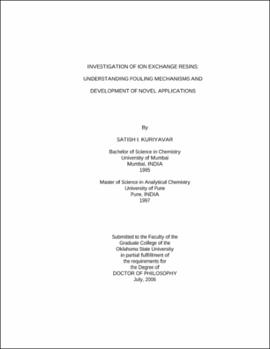| dc.contributor.advisor | Apblett, Allen | |
| dc.contributor.author | Kuriyavar, Satish I. | |
| dc.date.accessioned | 2013-11-26T08:21:27Z | |
| dc.date.available | 2013-11-26T08:21:27Z | |
| dc.date.issued | 2006-07 | |
| dc.identifier.uri | https://hdl.handle.net/11244/6460 | |
| dc.description.abstract | Scope and Method of Study: | |
| dc.description.abstract | Ion exchange resins play an important role in purifying water and a variety of industrial processes. One application, maintaining water purity in secondary steam cycle of nuclear power plants, has recently suffered from fouling of the resins due to the amine pH control agents that are added to reduce corrosion. This occurred after reactors switched from ammonia to ethanolamine (ETA) due to its superior corrosion protection. However the performance of the mixed bed ion exchange resins columns was found to occasionally degrade rapidly when ETA was present. Therefore, we adopted an approach of testing amines, in which the reactive functional groups of ETA are blocked by methyl groups. Another problem with ion exchange resins that was addressed was the need to develop means of rapidly separating them from a flowing water stream or separating radioactive resins by remote operations. | |
| dc.description.abstract | Findings and Conclusions: | |
| dc.description.abstract | The performed experiments led to the identification of 2-dimethylaminoethanol as a potential candidate to replace ETA and ammonia. Also, magnetic ion exchange resin beads that can be used for rapid feed-through separation by magnetic filtration were prepared. In other research, a method for converting ion exchange materials to spherical aggregates of metal oxide nanoparticles was developed. Cation exchange resins loaded with transition metal ions, such as iron and zinc on firing at 550 C yielded high surface area oxides capable of removing As(V). These agglomerates of metal oxides exhibit extremely good adsorption capacities when compared to the bulk metal oxides and, since they are replicas of ion exchange beads, they have appropriate hydrodynamic properties for flow-through water treatment. Water treated with these aggregates is in compliance with the new stringent US Environmental Protection Agency standard for arsenic for drinking water. | |
| dc.format | application/pdf | |
| dc.language | en_US | |
| dc.rights | Copyright is held by the author who has granted the Oklahoma State University Library the non-exclusive right to share this material in its institutional repository. Contact Digital Library Services at lib-dls@okstate.edu or 405-744-9161 for the permission policy on the use, reproduction or distribution of this material. | |
| dc.title | Investigation of ion exchange resins: Understanding fouling mechanisms and development of novel applications | |
| dc.contributor.committeeMember | Materer, Nicholas | |
| dc.contributor.committeeMember | Slaughter, LeGrande | |
| dc.contributor.committeeMember | Foutch, Gary L. | |
| osu.filename | Kuriyavar_okstate_0664D_1942.pdf | |
| osu.accesstype | Open Access | |
| dc.type.genre | Dissertation | |
| dc.type.material | Text | |
| thesis.degree.discipline | Inorganic Chemistry | |
| thesis.degree.grantor | Oklahoma State University | |
